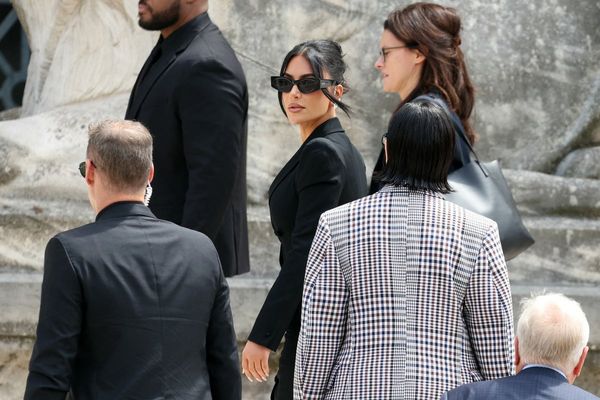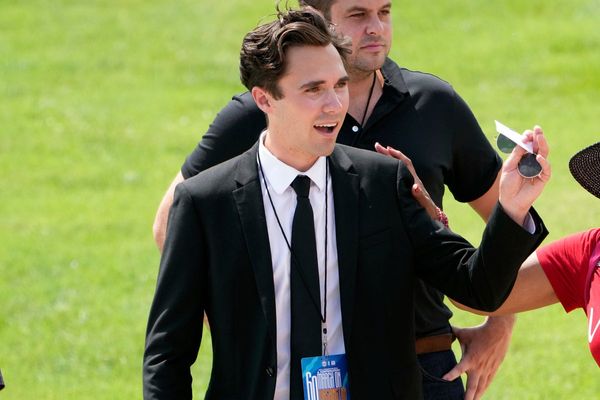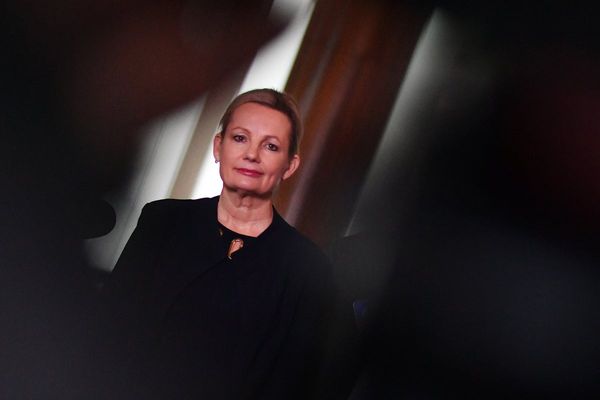/media/img/mt/2022/07/Atl_NYnov_v1/original.png)
Colson Whitehead once wrote that all it took to belong in New York City was an act of remembrance—the summoning of a piece of the city that no longer existed. “You are a New Yorker the first time you say, ‘That used to be Munsey’s’ or ‘That used to be the Tic Toc Lounge,’” he wrote. “You are a New Yorker when what was there before is more real and solid than what is here now.” Whitehead wrote this essay in 2001 and it’s easy to understand why he was reflecting on what was missing: Two towers had left the skyline, and 2,977 people were gone with them.
Two decades later, an author has again taken stock of the city’s relationship with memory. His name is Zain Khalid, and his debut novel, Brother Alive, feels like the first since the onset of the coronavirus pandemic that captures the mood of New York right now, describing a wounded city where, rather than holding on to what’s gone, residents are eager to rid themselves of the recent past.
[Read: What is crime in a country built on it?]
Brother Alive is a book of ideas, a book of fathers and sons, a magical-realist mystery, and a revenge story. It opens in Staten Island, “New York’s most disregarded borough” and where Khalid grew up. It’s there that the book’s protagonists, a trio of adopted brothers—Dayo, Iseul, and Youssef—grow up, in the care of Salim, a handsome, emaciated, polymathic imam. Salim is remote but loving with Dayo and Iseul, and cruel to Youssef, who narrates the first and best section of the novel.
Earth’s mightiest heroes often make their homes in New York, and the brothers, with their preternatural talents, leap off the book’s pages. With the gift of gab in multiple languages, Dayo embodies the city’s quest for wealth. Iseul is a gentle giant, athletic enough to play D1 college basketball and self-possessed enough that he’s the only brother who finds something resembling romantic love.
But it’s Youssef, the least loved son, who is the most complicated: He is shadowed by a mysterious figure called Brother, a shape-shifting creature that feeds on his memories and knowledge. Brother, who is initially reminiscent of Philip Pullman’s daemons (animal companions that represent the souls of their human counterparts) is both part of and distinct from Youssef. Mostly, he appears to Youssef in animal form, as in an early encounter, in which he takes the shape of “a dog the color of melted sun.” Youssef offers him a bite of an apple, then casts his eyes down at the fruit: “I couldn’t for the life of me identify what I was holding,” he says. “I took a bite, and it tasted how it smelled, but I didn’t have the word for it that I used to have.”
Brother is not a hallucination; he’s the incarnation of a condition shared by Youssef and his adoptive father. Salim’s disease is never given a name or manifested as a transforming animal companion, but it also causes him to forget the past. Youssef and Salim clash fiercely, but have plenty in common: Intellectuals and storytellers, they share a fierce distaste for American politics. We are told early on that Salim’s proudest legacy may be successfully encouraging his neighbors and friends not to vote.
These themes—political cynicism and forgetfulness—define New York right now. Where Whitehead’s 2001 New York was a city that came together, determined to hold on to its past, New York is now a place where turnout for the last mayoral election hit a record low and the words Never forget have been traded in for a shared sense of amnesia that clouds the loss of the more than 40,000 New Yorkers (and counting) killed by COVID. They’ve received no museum, no sacred memorial. To an extent, that’s because the pandemic doesn’t come with an end date. It’s also because this time, instead of going to war with some external foe, the war we’ve waged and continue to fight—over masks, vaccine mandates, and nearly every other aspect of the past two and a half years—is with ourselves.
[Read: A visual history of New York City’s fictional destruction]
Youssef’s dilemma as a character mirrors this New Yorker identity crisis—though he’s deeply engaged with the world, with politics and literature, he cannot find a system or an institution to believe in, or to belong to. So instead, he accepts and even loves Brother—who strips him of the pain of unbelonging by robbing him of his memories. As the book progresses, Brother becomes more powerful, taking more and more from Youssef, leaving him a passive participant in his own life, in thrall to a force he cannot control.
But Brother Alive isn’t all darkness. Its cynicism is countered by the incredible warmth with which Khalid writes about his city. Early on, he describes a summer in Coolidge, a fictionalized version of several Staten Island neighborhoods, where the boys grow up:
“As the nights warmed and the air became the same temperature as our skin and the sun resisted setting until the moon was in the middle of its shift, Coolidge’s streets thrummed with activity,” he writes. “Rebounds of Wu-Tang, Dipset, and early Drill caromed off parked cars and the deep concrete.” The boys learn that “all parts of a pig are delicious, including the feet,” and enjoy watermelon, curries, flan, and generic-brand cola. Their neighborhood bustles with food and music and people, strangers who can become family.
Despite his novel’s political pessimism, Khalid can never quite bring himself to condemn New York. Another standout scene takes place at Ground Zero in 2003, where Dayo and Youssef sell trinkets at a makeshift stand honoring “First responder, William August Corrigan.” They are Muslim American teenagers suffering through the worst of the period’s Islamophobia, so there’s a clear logic to their grift: They feel like they, too, are casualties of the attacks. When the tourists stop expressing interest in the merchandise, Dayo pivots to a bit of pristine trollery, giving an improvised speech in which he aligns himself with the attackers: “Two years ago, after centuries of Western subjugation, my brothers struck a blow against the neocolonialist Zionist regime …” He’s rewarded with a crowd of spectators—but then a cop intercedes, and the two brothers are forced to make a quick getaway. Upon escaping, they receive free food from a pair of Hindi-speaking street vendors, in a textbook moment of melting-pot sentimentality.
Afterward, Dayo points out the name of the ferry they plan to take home: Spirit of America. “Are you American? Have you ever felt American?” Dayo asks Youssef, who says no. “No one is,” Dayo responds. “Not that we’re anything else, but this idea, to pledge yourself to any nation-state, to these old and corrupted ideas, it’s a disease, and it’ll rot our brains if we’re not careful.” He shouts at the ferry: “Just fucking sink already.”
[Read: How to belong in America]
This quick sequence of ideological pivots—two instances of anti-American sentiment bookending a scene of New Yorkers helping New Yorkers—is characteristic of the book’s first section. Its contradictions make it glow. It’s thick with ideas, imagination, wordplay, name-dropping, notable NYC cameos (Argosy! The 13th Step!), and casual acts of writerly daring, which occasionally go overboard. Read it with a pen and you’ll expend more ink than a zealous NSA redactor.
Would that the rest of Brother Alive were as strong as its first act. When the book leaves the city, it tumbles off its axis. The street scenes, the density, the atmospheric reality undergirding Khalid’s fantasy disappears. The second section is narrated in a letter from Salim written in Saudi Arabia. We learn that Salim was close with the boys’ birth fathers, that together they sought to build a vaguely described pan-Islamic utopia, and that they made an enemy of a powerful mufti named Ibrahim, which resulted in the deaths of the three fathers and the sons’ adoption. But without the backdrop of New York, the abstractions pile up and the churning plot ceases to satisfy.
Some bright moments remain. In the third section, Youssef is once again narrating and the action returns—all too briefly—to the city. The brothers are on the top floor of the tallest building in Staten Island:
The building was new construction, elegant, soulless, filled with East Asians and whites. The kind of place that we, card-carrying denizens of old Coolidge, were supposed to hate. I couldn’t hate, though. Beyond each of their windowed walls was the whole of New York. And on that evening, with the night sky congealing in advance of a nor’easter, the city was a glittering necklace worn by an unworthy horizon … What am I supposed to say? New York remains New York.
This book, so focused on the past, sometimes seems to have little optimism for the future. But some of Khalid’s best writing comes when he has Youssef wax eloquent about whatever’s on the horizon. Even though Brother Alive is far from hopeful, wrestling with intellectual and political energies that seem to have no appropriate outlet, Youssef, and his author, maintain a sense of delirious wonder throughout. It’s a very New York quality: Every so often, the cynicism falls away and the sentiment—the affection that keeps us in this worn-out city—shines through.







